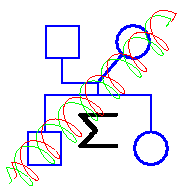
(a) Three independent studies are made of linkage between a pair of loci. The first results in x1 recombinants, and n1 - x1 non-recombinants between A and B. The second results in x2 recombinants and n2-x2 non-recombinants between B and C. The third results in x3 recombinants and n3-x3 non-recombinants between A and C. Suppose it happens that xi/ni (i=1,2,3) are all less than 1/2. Making no assumptions about interference, what are the MLEs of r1, r2, and r?
(b) Note that, in the absence of any genetic interference,
r = r1 (1-r2) + r2 (1-r1).
Show that, in the absence of genetic interference, the expected number
of AC recombinants that are recombinant in AB but not in BC is
x3 r1 (1-r2)/
(r1 (1-r2) + r2 (1-r1)),
and that the
expected number of AC non-recombinants that are recombinant both in AB
and in BC is
(n3 -x3) r1 r2 /
(r1 r2 + (1-r1 )(1-r2)).
Describe an
EM algorithm which will provide the MLEs of r,
r1 and r2
in the absence of genetic interference.
(c) How would you test the absence of genetic interference, given the above data?
2. A second investigator has a different design for estimating
recombination frequencies between the same three loci, A, B, C of the
previous question. She
m=
(2/3)(n1+n2+n3) gametes at all three
loci. (So she has done the same total number of typings as in Qu. 1.)
She finds y11 that are both AB and BC recombinants,
y10 that are AB recombinants and BC non-recombinants,
y01 that are AB non-recombinants and BC recombinants,
and y00=
m - y11 -y10 -y01
that are non-recombinant in
both intervals.
(a) How should this investigator estimate the recombination frequencies r1 and r2 ?
(b) How would you advise this investigator to test the absence of genetic interference?
(c) Which design (Qu.1 or Qu. 2) do you expect to provide more information for detecting genetic interference? Very briefly, how would you measure this information in order to make this comparison?